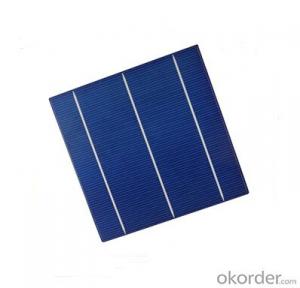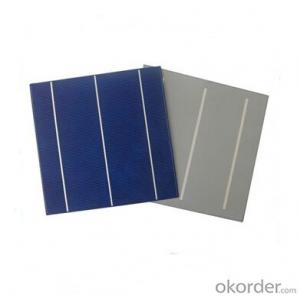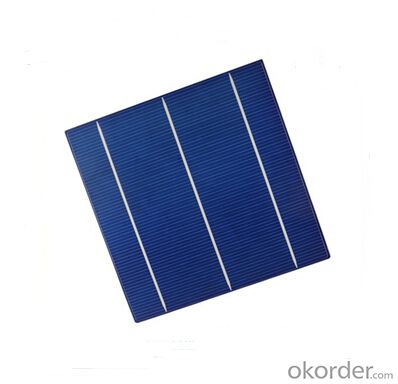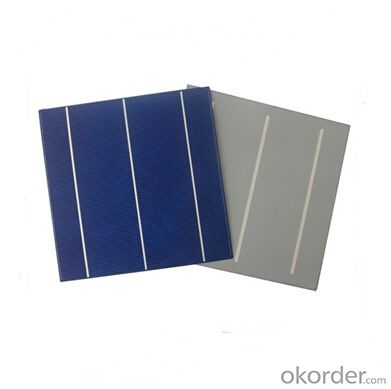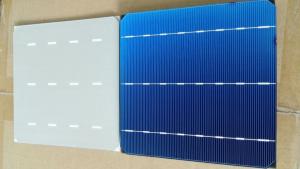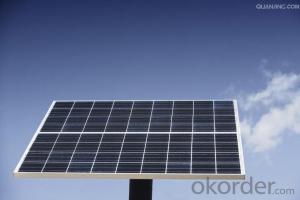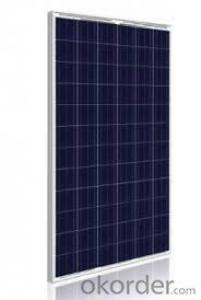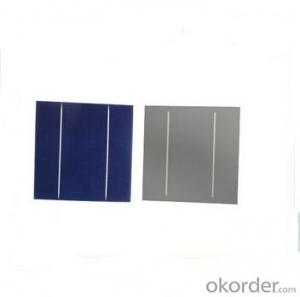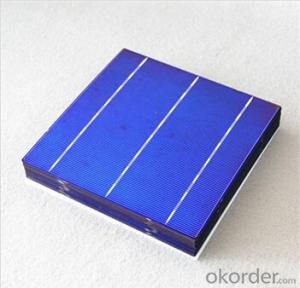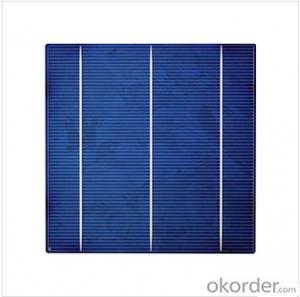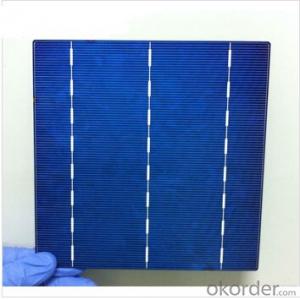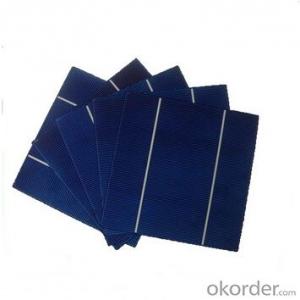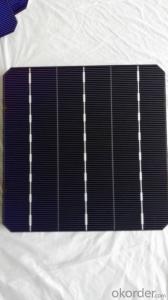Custom Polycrystalline Solar Cells Series- 17.8%156mm×156mm±0.5mm
- Loading Port:
- Shanghai
- Payment Terms:
- TT OR LC
- Min Order Qty:
- 3000 pc
- Supply Capability:
- 1000000 pc/month
OKorder Service Pledge
OKorder Financial Service
You Might Also Like
Solar Cells:
Solar cells is made by solar wafer, it has three categories of solar cell right now, monocrystalline polycrystalline and thin film,These cells are entirely based around the concept PN junction, which is the critical part of solar module, it is the part that can convert the light energy into electricity, the thickness is from 180um to 200um, with even busbars to conduct electricity, textured cell can decrease diffuse reflection; they are often electrically connected and encapsulated as a module. Photovoltaic modules often have a sheet of glass on the front (sun up) side, allowing light to pass while protecting semiconductor wafers from abrasion and impact due to wind-driven debris, rain, hail, etc. Solar cells are also usually connected in series in modules, creating an additive voltage. Connecting cells in parallel will yield a higher current;With high quality and stable quality. Our Cells can greatly improve the performance of Solar Modules.
Features:
1. High conversion efficiencies resulting in superior power output performance.
2. Outstanding power output even in low light or high temperature conditions
3. Optimized design for ease of soldering and lamination
4. Long-term stability, reliability and performance
5. Low breakage rate
6. Color uniformity
Solar Cells Advantage:
1. Tire-1 Solar Cells’ Manufacturer Quality Guarantee. With a complete and sophisticated quality government system, our Quality Management have arrived world’s leading place. Customer can receive Tire-1 Cells Maker’s Quality Standard Products.
2. Trusted Warranty. We can supply trusted after-sales service to our customer. If our cells are found not in conformity to the specification of manufacturer, or should the inspected quantity found in shortage, or should the packing found damaged, the buyer has the right to claim to the seller. The claim, if any, should be presented to seller within 30 days after cargo's arrival date to the port, together with related inspection report and photos issued and provided by a reputable independent surveyor such as SGS.
3. World’s Leading Manufacturer Equipment. We imported the newest and leading production equipment from abroad. Advanced equipment can guarantee the stable quality of cells. Auto production line can also save labor cost which will further cut our production cost.
4. Bulk supply: With the production capacity of 500MW, we can produce large quantity every month. This can satisfy most customer requirement.
Specifications:
1.Size:156x1156±0.5mm thickness:200±20μm
2.Covered with derk blue silicon nitride antireflection coating;3 busbars of 1.5mm width and 80 fingers
3.Covered with aluminun BSF;15 welded substrate(silver)of 9x3mm size.
Format | 156mm×156mm±0.5mm |
Thickness | 210μm±30μm |
Front(-) | 1.4mm bus bars(silver), blue anti-reeecting coating(silicon nitride) |
Back(+) | 2.0mm wide soldering pads(silver) back surface eld(aluminum) |
Efficiency(%) | Pmpp (W) | Umpp(V) | Impp(A) | Uoc(V) | Isc(A) | FF(%) |
17.80-18.00 | 4.33 | 0.53 | 8.159 | 0.633 | 8.709 | 78.44 |
17.60-17.80 | 4.29 | 0.527 | 8.126 | 0.631 | 8.677 | 78.27 |
17.40-17.60 | 4.24 | 0.524 | 8.081 | 0.628 | 8.629 | 78.17 |
17.20-17.40 | 4.19 | 0.521 | 8.035 | 0.625 | 8.578 | 78.08 |
17.00-17.20 | 4.14 | 0.518 | 7.99 | 0.623 | 8.531 | 77.97 |
16.80-17.00 | 4.09 | 0.516 | 7.938 | 0.62 | 8.478 | 77.85 |
16.60-16.80 | 4.04 | 0.514 | 7.876 | 0.618 | 8.419 | 77.68 |
16.40-16.60 | 3.99 | 0.511 | 7.813 | 0.617 | 8.356 | 77.51 |
16.20-16.40 | 3.94 | 0.509 | 7.754 | 0.615 | 8.289 | 77.4 |
16.00-16.20 | 3.9 | 0.506 | 7.698 | 0.613 | 8.22 | 77.36 |
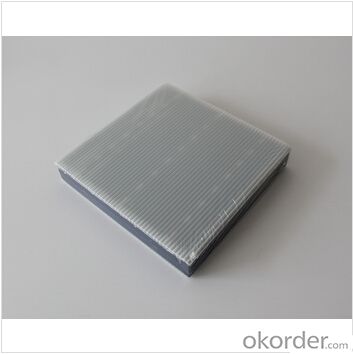
FAQ
We have organized several common questions for our clients,may help you sincerely:
①What price for each watt?
It depends on the efficiency of the solar cell, quantity, delivery date and payment terms.
②How long can we receive the product after purchase?
In the purchase of product within three working days, We will arrange the factory delivery as soon as possible. The pecific time of receiving is related to the state and position of customers.Commonly 7 to 10 working days can be served.
③Can you provide the peripheral products of the solar panels, such as the battery, controller, and inverter? If so, can you tell me how do they match each other?
Yes, we can, we have two companies for solar region, one is CNBM International, the other is CNBM engineering Co.
We can provide you not only the solar module but also the off grid solar system, we can also provide you service with on grid plant.
④What is your warranty of solar cell?
Our product can promise lower than 0.3% open box crack, we support claim after opening the box if it has crackm color difference or sth, the buyer should give pictures immediately, we can not accept the claim after the solar cell has assembled to solar panel.
• Timeliness of delivery
• ⑤How do you pack your products?
We have rich experience on how to pack the solar cell to make sure the safety on shipment, we could use wooden box or pallet as buyer's preference.
- Q: What are the tin bands, sinks and interconnections used on solar modules, and what are the solar cells used in the solar cells?
- Light incident on the side of the general agreement for the positive, ordinary p-type battery front pn knot is the final need to use, and the back is called back knot.
- Q: What is the difference between a solar cell and a solar panel?
- A solar cell is the basic unit that converts sunlight into electricity, while a solar panel is a collection of multiple solar cells arranged in a larger structure to generate a higher amount of electricity.
- Q: How do solar cells handle electrical surges or lightning strikes?
- Solar cells have built-in protective measures to handle electrical surges or lightning strikes. They are typically equipped with surge protectors or arresters that divert the excess electrical energy away from the cells, ensuring their safety. These protective devices help prevent damage to the solar cells and the overall system by redirecting the high voltage and current caused by surges or lightning strikes to the ground.
- Q: Are solar cells affected by pollution?
- Yes, solar cells can be affected by pollution. Airborne pollutants, such as dust, smog, or industrial emissions, can accumulate on the surface of solar panels, reducing their efficiency by blocking sunlight and decreasing their output. Regular cleaning and maintenance are essential to ensure optimal performance of solar cells in polluted environments.
- Q: Are there any subsidies or incentives for installing solar cells?
- Yes, there are various subsidies and incentives available for installing solar cells. These can include federal tax credits, state and local incentives, grants, and rebates. These measures aim to promote the adoption of solar energy and make it more affordable for individuals and businesses to invest in solar panel installations.
- Q: What are the environmental impacts of solar cell production?
- The environmental impacts of solar cell production include the extraction of raw materials, such as silicon, which can contribute to deforestation and habitat destruction. The manufacturing process also requires a significant amount of energy, which may be sourced from fossil fuels and contribute to greenhouse gas emissions. Additionally, the disposal and recycling of solar panels can pose challenges, as some components contain harmful substances. However, it is important to note that the overall environmental benefits of solar energy, such as reduced greenhouse gas emissions and reliance on fossil fuels, outweigh these impacts.
- Q: Can a solar cell be used in commercial buildings?
- The answer is absolutely yes!
- Q: How do solar cells perform in areas with high levels of air pollution?
- Solar cells perform less efficiently in areas with high levels of air pollution. Air pollution, especially particulate matter and smog, can block sunlight and reduce the amount of light reaching the solar cells. This reduces their ability to generate electricity and can significantly decrease their performance. Additionally, air pollution can settle on the surface of the solar panels, creating a layer of dirt or dust that further reduces their efficiency. Regular cleaning and maintenance are required to ensure optimal performance in such areas.
- Q: Is A grade better than the B grade when we buy the poly solar cells.
- I think the A grade is better than B grade, but just not sure how better it can be compared to the others.
- Q: Can solar cells be used in marine applications?
- Yes, solar cells can be used in marine applications. They can be installed on boats, ships, or other marine vessels to generate electricity from the sun. These solar cells can power various onboard systems and equipment, reducing the dependency on traditional fuel sources and providing a sustainable energy solution for marine applications.
Send your message to us
Custom Polycrystalline Solar Cells Series- 17.8%156mm×156mm±0.5mm
- Loading Port:
- Shanghai
- Payment Terms:
- TT OR LC
- Min Order Qty:
- 3000 pc
- Supply Capability:
- 1000000 pc/month
OKorder Service Pledge
OKorder Financial Service
Similar products
Hot products
Hot Searches
Related keywords
